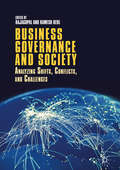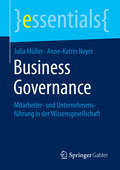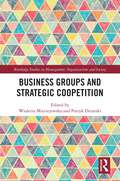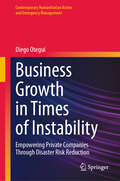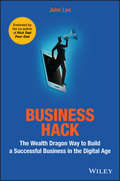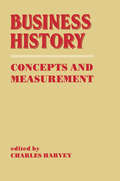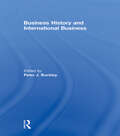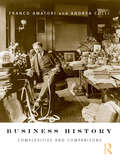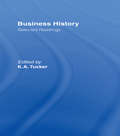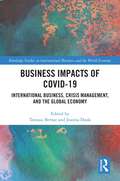- Table View
- List View
Business Governance and Society: Analyzing Shifts, Conflicts, And Challenges
by Rajagopal Ramesh BehlThis volume critically analyzes the convergence of technology, business practices, public policies, political ideologies, and societal values for improving business performance at the global-local paradigm. It also enriches knowledge on contemporary business strategies against conventional wisdom of managing companies today. Shifts in the global economic and political order have significantly affected the business patterns within developed, developing, and emerging markets. The reversal of political ideologies from liberal to protectionist business frameworks are disrupting the trade flows that were rooted in the international economy since the mid-twentieth century.The essays contemplate developing new visions and business perspectives to match with the changing political ideologies in emerging markets. This volume will serve as a valuable tool to readers looking for global market management strategies to generate cost-effective business models and create convergence with political and social values to drive better governance of businesses.
Business Governance: Mitarbeiter- und Unternehmensführung in der Wissensgesellschaft (essentials)
by Julia Müller Anne-Katrin NeyerJulia Müller und Anne-Katrin Neyer erläutern in kompakter Weise, basierend auf ausgewählten Forschungsbeiträgen der Mitarbeiter- und Unternehmensführung, die Instrumente, die Ziele und die Situationen der Business Governance und deren Zusammenhänge. Anhand der Business Governance Formel zeigen die Autorinnen, dass Instrumente der Mitarbeiter- und Unternehmensführung so zu wählen sind, dass sie im Einklang mit Unternehmenszielen und -situationen stehen. Durch das ganzheitliche Konzept der Business Governance können Führungskräfte - wenn sie Business Governance im Unternehmen (vor)leben - Unternehmen zielgerichtet in die richtige Richtung führen.
Business Groups And Transnational Capitalism In Central America
by Benedicte Bull Fulvio Castellacci Yuri KasaharaThis book investigates Central America's political economy seen through the lens of its powerful business groups. It provides unique insight into their strategies when confronted with a globalized economy, their impact on development of the isthmus, and how they shape the political and economic institutions governing local varieties of capitalism.
Business Groups and Financial Markets: A Weberian Analysis
by Sandro SegreThis work builds on the classical sociological contributions of Weber, Simmel, and Toennies, and makes the case for different and alternative ideal-typical models of business relations, which the author calls "English" and "German."The "English" model of business relations is characterized by free competition between firms. They abide by the ethical rules of fair business and the moral economy in market exchanges. Their relations are accordingly based on mutual trust. As a rule, they do not cultivate privileged relations with political authorities.By contrast, the "German" model involves hierarchical relations between a group's major firm and its smaller units. There is no moral community binding together the different groups, and therefore no mutual trust between them. Business groups maintain close relations, based on reciprocal favours, with authorities.The author compares the London and New York Stock Exchanges in the late nineteenth century, finding the former better approximates the "English" model, and shows this model's superior performance. "English" model countries such as Taiwan have been shown to be more competitive in market exchanges than countries such as South Korea, which approximate the "German" model. A new epilogue makes use of more recent information and confirms Segre's arguments.
Business Groups and Strategic Coopetition (Routledge Studies in Management, Organizations and Society)
by Patryk Dziurski Wioletta MierzejewskaBusiness Groups and Strategic Coopetition sheds lights on the poorly recognised problem of intra-organisational relationships within business groups by adopting the coopetition lens. It brings together the strategic management (coopetition and performance) and international management perspectives (business groups and its role in the economy). It is a unique proposition as those two research streams, such as business groups and coopetition, are rarely assessed together. The coopetition, which is seen as the strategy of value creating in the rapidly changing environment, brings benefits, such as an increased innovation, cost reduction, access to resources, and improved competitive position that could be capture by business groups as well. However, the understanding of complex organisations, such as business group, and answering the question how to manage intra-level coopetition to gain better performance therein is still unclear. Therefore, the book aims to extends the knowledge in the field of internal relationships within business groups as well as the coopetition phenomenon. This book is written to meet needs of researchers, students as well as managers and to present an integrated view on the coopetition within business groups.
Business Groups and the Thailand Economy: Escaping the Middle-Income Trap (Routledge Focus on Business and Management)
by Natenapha WailerdsakBusiness Groups and the Thailand Economy examines the role of business groups, specifically state, local, and foreign capitals in the economic development of emerging economies and highlights why business groups are essential in helping a country break out of the middle-income trap. Wailerdsak reviews Thailand’s industrial and economic growth strategies through the local and international investors and explains why business groups are one of the key drivers of economic advancement and why they help to avoid the middle-income trap. The author also examines their business power expansion methods, including selection and specialization, political influence, mergers and acquisitions, outward FDI and business alliances. The book concludes with policy recommendations of how the government can engage business groups to accelerate high-tech industrialization and create jobs.The middle-income trap issue faced by Thailand would be of interest to many emerging economies, especially scholars and policymakers researching on Asian business and management, Asian economies, developmental economics, political economy, policy studies, corporate governance, entrepreneurship, and private company strategic management in emerging countries.
Business Groups and the Thailand Economy: Escaping the Middle-Income Trap (Routledge Focus on Business and Management)
by Natenapha WailerdsakBusiness Groups and the Thailand Economy examines the role of business groups, specifically state, local, and foreign capitals in the economic development of emerging economies and highlights why business groups are essential in helping a country break out of the middle-income trap.Wailerdsak reviews Thailand’s industrial and economic growth strategies through the local and international investors and explains why business groups are one of the key drivers of economic advancement and why they help to avoid the middle-income trap. The author also examines their business power expansion methods, including selection and specialization, political influence, mergers and acquisitions, outward FDI and business alliances. The book concludes with policy recommendations of how the government can engage business groups to accelerate high-tech industrialization and create jobs.The middle-income trap issue faced by Thailand would be of interest to many emerging economies, especially scholars and policymakers researching on Asian business and management, Asian economies, developmental economics, political economy, policy studies, corporate governance, entrepreneurship, and private company strategic management in emerging countries.The Open Access version of this book, available at http://www.taylorfrancis.com, has been made available under a Creative Commons Attribution-Non Commercial-No Derivatives (CC BY-NC-ND) 4.0 license.
Business Growth in Times of Instability: Empowering Private Companies Through Disaster Risk Reduction (Contemporary Humanitarian Action and Emergency Management)
by Diego OteguiThis book aims to be a comprehensive resource for crafting strategies to help private companies navigate and thrive in unpredictable and challenging operational landscapes. This endeavor is rooted in the desire to furnish decision-makers with a structured framework and practical tools, empowering them to facilitate business growth even during times of crisis. At the heart of this overarching goal lies a tangible mission: encouraging businesses to become proactive and influential participants in disaster risk reduction. This inquiry seeks to uncover the active contributions that the private sector can make, understand why its involvement is crucial, and identify effective strategies to harness its capabilities. The book discusses disaster risk reduction as a valid corporate strategy to maintain business continuity, but also as a means to increase market share. It presents a very detailed and easy-to-follow strategy for private businesses willing to take advantage of opportunities within a context of instability while helping increase community resilience to disaster risk and humanitarian crises. To do so, it merges business and institutional theory complemented by the author's personal accounts and experience. Business Growth in Times of Instability: Empowering Private Companies Through Disaster Risk Reduction will be a valuable resource for corporate leaders interested in learning about the dual disaster risk they face – the direct impact of a disaster event and the indirect impact created by the impact in the market – and finding tools to not only face these risks but also grow their businesses, even in times of instability.
Business Guide for Strategic Management: 50 Tools for Business Success
by Alfred-Joachim HermanniThis book follows the credo "Don't work hard - work smart". Smart in the sense of cleverness, systematic organization of work and time as well as farsightedness to open up business perspectives. In alphabetical order, the book presents the success factors, methods and strategies that help strengthen market positions and realign strategies. The clear chapters are also very suitable for reference.The book is aimed at managers, executives and self-employed people who want to use their most valuable resources sustainably and consciously to develop products and services that customers really want. Over 100 national and international case studies provide a high utility value. For the 2nd edition, numerous text passages have been revised, new case studies have been integrated and up-to-date data material has been made accessible. With valuable practical tips at the end of each chapter. The electronic usage of the German-language edition of the book has so far led to more than 1.6 million accesses.
Business Guide für strategisches Management: 50 Tools zum geschäftlichen Erfolg
by Alfred-Joachim HermanniDieses Buch folgt dem Credo ,,Don´t work hard - work smart". Smart im Sinne von Cleverness, systematischer Organisation und Weitsichtigkeit zur Erschließung geschäftlicher Perspektiven. In 50 Kapiteln werden Erfolgsfaktoren, Methoden und Strategien vorgestellt, die helfen Marktpositionen zu stärken und Strategien neu auszurichten. Das Buch richtet sich an Manager, Führungskräfte und Selbstständige, die ihre wertvollsten Ressourcen nachhaltig und bewusst einsetzen wolle, um Produkte und Dienstleistungen zu entwickeln, die die Kunden auch wirklich wollen. Tipps am Ende der Kapitel ermöglichen die direkte Umsetzung in die Praxis.
Business Guide für strategisches Management: 50 Tools zum geschäftlichen Erfolg
by Alfred-Joachim HermanniDieses Buch, nun in der 2. Auflage, folgt dem Credo „Don´t work hard – work smart“. Smart im Sinne von Cleverness, systematischer Organisation von Arbeit und Zeit sowie Weitsichtigkeit zur Erschließung geschäftlicher Perspektiven. In alphabetischer Reihenfolge stellt das Buch die Erfolgsfaktoren, Methoden und Strategien vor, die helfen Marktpositionen zu stärken und Strategien neu auszurichten. Die übersichtlichen Kapitel sind auch zum Nachschlagen sehr geeignet.Das Buch richtet sich an Manager, Führungskräfte und Selbstständige, die ihre wertvollsten Ressourcen nachhaltig und bewusst einsetzen wollen, um Produkte und Dienstleistungen zu entwickeln, die die Kunden auch wirklich wollen. Über 100 nationale und internationale Fallbeispiele liefern einen hohen Nutzwert. Für die 2. Auflage wurden zahlreiche Textstellen überarbeitet, neue Fallbeispiele intergriert und aktuelles Datenmaterial erschlossen. Mit wertvollen Praxistipps am Ende jedes Kapitels.
Business Guide to Japan
by Boye Lafayette De MenteConducting business in Japan: a delicate and valuable skill is explained by a true master of Japanese culture.Not only is Japan the world's third largest economy, it is a global center for design for non-Japanese businesses looking to expand into international markets.But business people from outside Japan quickly discover that doing business in Japan is unlike anything they've experienced before. They find Japanese business culture both highly regimented and maddeningly impenetrable-making it difficult to identify, much less approach, key decision-makers, or to bring negotiations to a successful close.Japanologist Boye Lafayette De Mente explains the key aspects of Japanese business practices and protocols with specific advice for approaching and engaging with Japanese executives, their staffs, and their organizations.Business Guide to Japan offers you invaluable insights into how to unravel the complicated maze of business bureaucracy, interpret verbal and written messages from your contacts, and create the critical social "comfort zone" necessary for working with Japanese companies. Doing business with the Japanese can be both challenging and rewarding, and the Business Guide to Japan offers you precise guidelines for success.
Business Guide to the Philippines (Business Guide To Asia Ser.)
by Donald KirkThe Business Guides are aimed at business people requiring an accurate and up-to-date guide to how business is orfganised and regulated in Asia.Business Guides aim to cover : *negociation preparation *foreign trade *Customs *business law *financing *marketing and distribution *taxation *intellectual property *foreign investment *economic conditions and trends The Business Guide to the Philippines, part of the Business Guide to Asia Series, provides detailed information on setting up and running business ventures in the Philippines.All contributors are experts and specialists in their fields, providing you with an unparalleled wealth of insider knowledge. Each chapter is packed with the kind of information and advice usually available only to elite clients with large budgets for outside consultants.Business Guides will include th following countries: *Japan *Malaysia *Hong Kong *India *Thailand *Korea *Indonesia *China * Singapore *Taiwan *Vietnam, Laos, Cambodia
Business Hack: The Wealth Dragon Way to Build a Successful Business in the Digital Age
by John LeeMaster the online tools available to grow your business and conquer the competition Business Hack is your essential roadmap to business growth and online marketing success. Author and successful entrepreneur John Lee shares his proven methods to harness the power of online tools, including using social media—offering practical steps to create and implement highly effective cyber-marketing campaigns. Thanks to the digital revolution, you no longer need teams of marketing experts and other expensive overheads to build and promote your business. This unique and valuable resource covers everything you need to consider when building your marketing strategy, from established principles of sales to cutting-edge digital techniques. In today’s dynamic business environment, strong and ongoing engagement in social media marketing is no longer an option–it is a necessity. From local craft-based businesses to new tech start-ups and even global multinational corporations, effective cyber-marketing can be instrumental in determining success. A comprehensive digital strategy enables you to compete across all platforms and maintain viability and relevance in the face of intense competition. Following the proven techniques in this essential guide allows you to: Implement powerful social media marketing campaigns to increase revenue and rise above the competition Integrate traditional sales and advertising methods with modern technology to create a comprehensive business marketing strategy Identify future trends to stay ahead of the technology curve and capitalize on new opportunities. Learn the skills used by successful entrepreneurs and respected experts in online marketing The Internet and rise of digital media have changed the rules of business and marketing. It is now possible for small and new businesses to compete and thrive in the global marketplace through intelligent use of digital and social media marketing. Business Hack provides the tools and knowledge necessary to succeed in the 21st century.
Business History
by Charles HarveyFirst Published in 1989. Routledge is an imprint of Taylor & Francis, an informa company.
Business History and International Business
by Peter J. BuckleyBusiness History and International Business are cognate subjects. There are few, if any, studies of international business that do not require a proper study of context. International business decision making must be made relevant by a considered evaluation of the circumstances surrounding that decision. This often means putting it into its historical context. The contributions that the study of international business can make to business history are the input of appropriate theory and appropriate research methods. The best international business theory can illuminate the seemingly disparate strategies of firms in given historical circumstances and can provide an integrated, overarching conceptual structure of the study of business history. The research methods used in international business are also worthy of scrutiny by business historians. The proposition of this book is that international business theory and method can complement business history. This cross-fertilization has been occurring with increasing regularity over the past few decades and this book brings together some of the fruits of this conjunction of two important intellectual domains. This book was published as a special issue of Business History.
Business History of Hospitals in the 20th Century: Entrepreneurship, Organization, and Finances (Frontiers in Economic History)
by Paloma Fernández PérezThis book offers a business history of modern hospitals in the 20th century. Presenting case studies from around the world, it examines the long-term institutional and historical evolution of hospital organization and management models, applying a business history approach to do so. Drawing on reports from international organizations and other historical data, it explores the evolution, path dependencies, actors and institutions that have shaped the diversity of hospital organization and management models. At the same time, it analyzes the historical origins of major problems faced by today’s hospitals, such as cost-inefficiencies, lack of specialized human capital, etc. The contributing authors cover topics such as the history of hospital finance and accounting, hospital price regulation, entrepreneurship models, hospital privatization, and hospital governance. The book will appeal to scholars and students of economic and business history, and to anyone interested in the history of hospitals.
Business History: A Research Overview (State of the Art in Business Research)
by John F. Wilson Steven Toms Emily Buchnea Nicholas Wong Ian G. Jones Anna TilbaThe evolution of business history offers some radical ways forward for a discipline which is rich in potential. This shortform book offers an expert overview of how the field has relevance for contemporary business studies as well as the social sciences more broadly, as well as practitioners interested in historical perspectives. This book not only provides a comprehensive review of how the discipline of business history has evolved over the last century, but it also lays out an agenda for the next decade. Focusing specifically on the ‘three pillars’ of research, teaching and practical impact, the authors have outlined how while the first has flourished across many continents, the latter two are struggling to overcome significant challenges associated with how the discipline is perceived, especially in the social sciences. A solution is proposed that would involve academics working more closely with practitioners, thereby increasing the discipline’s credibility across key stakeholders. The work here presented provides a concise and easily digestible overview of the topic which will be of interest to scholars, researchers and advanced students focusing on the evolution of business history and its impact on the way the world conducts business today.
Business History: Complexities and Comparisons
by Andrea Colli Franco AmatoriThis major new textbook on business history brings together the expertise of two internationally renowned authors to provide a thorough overview of the developments in business – from just before the industrial revolution right up to the present day. Business History is global in scope and looks at the major players – Europe, the US and Japan – as well as emerging economies, such as China and India. Focusing mainly on ‘big business‘, Amatori and Colli critically analyze ‘the firm‘ and its interaction with the evolution of economic, technological and political systems at the micro and macro levels. This up-to-date textbook is an exceptional resource for students on economic and business history courses, as well as for practitioners interested in broadening their understanding of business.
Business History: Selected Readings
by K. A. TuckerThis selection of readings demonstrates the use of both descriptive analysis and quantitative methods in the study of business records. The emphasis, however, is on the role of various quantitative approaches. Part I contains articles that consider a number of questions about the methods to be used and the aims of business history research. How is the subject to be defined? What types of analysis are most useful in research? In what ways can the findings of any research he used? Part II provides a number of examples of business history writing that demonstrate the results of a quantitative approach using both Primary and secondary source material. Some of the papers concentrate on the growth and performance of firms from various sectors of the economy. Some consider features of industrial structure. Others concentrate on techniques of marketing, personnel management and the assessment of profitability. Part III focuses on the techniques of manage meat that have been used to motivate or control the development of business activity. The studies include an analysis of the role of accounting data and other types of information, aids to forecasting, market analysis and the problems of risk and uncertainty in business decision making within various contexts. The editor has not only provided an introduction to the reprinted articles but he has also included, in Part IV, several special appendices useful for future research in business history. There is a section on allowing for changes in the unit of account. Another appendix deals with the merits and limitations of financial ratio analysis. An extensive bibliography is also provided. This authoritative text was first published in 1977.
Business History: Selected Readings
by Kenneth. A. TuckerFirst Published in 1977. This set of readings has been planned to demonstrate good examples of the writing of business history using a wide range of source material. Furthermore, the intention is to aid the development of critical perception and facilitate further analysis. The overriding criterion in selection has therefore been the framework of structure-conduct-performance for the industry, activity or firm. The emphasis is on the technical and organisational relationships between the governing factor input and output conditions and the objectives and control mechanisms of the decision-making personnel.
Business Impacts of COVID-19: International Business, Crisis Management, and the Global Economy (Routledge Studies in International Business and the World Economy)
by Tomasz BernatThe coronavirus disease (COVID-19) pandemic has caused serious disruptions to the economy and business activities. The COVID-19 crisis has also exposed important weaknesses in business and supply chains. It pointed to specific sectors of the economy, primarily related to services, that suffered the most. On the other hand, it has highlighted the great flexibility of the activities of entrepreneurs in their attempts to fight the crisis. The role of government has also been important in tackling this pandemic crisis to contain the epidemic and adopt activities to help entrepreneurs who were most affected by the crisis. Numerous national aid and recovery packages have been announced to support businesses and workers. At the same time, financial decisions were made at the international level, resulting in the mobilization of huge funds that were intended to support the functioning of enterprises. This book shares observations and conclusions from contemporary research and analyses, as well as from personal experiences in creating and implementing anti-crisis solutions in economies and enterprises caused by the COVID-19 pandemic on the economy and its entities. It will be of interest to researchers, academics, policymakers, and students in the fields of international business, economics, crisis management, and entrepreneurship.
Business Impacts of COVID-19: International Business, Crisis Management, and the Global Economy (Routledge Studies in International Business and the World Economy)
by Tomasz BernatThe coronavirus disease (COVID-19) pandemic has caused serious disruptions to the economy and business activities. The COVID-19 crisis has also exposed important weaknesses in business and supply chains. It pointed to specific sectors of the economy, primarily related to services, that suffered the most. On the other hand, it has highlighted the great flexibility of the activities of entrepreneurs in their attempts to fight the crisis.The role of government has also been important in tackling this pandemic crisis to contain the epidemic and adopt activities to help entrepreneurs who were most affected by the crisis. Numerous national aid and recovery packages have been announced to support businesses and workers. At the same time, financial decisions were made at the international level, resulting in the mobilization of huge funds that were intended to support the functioning of enterprises.This book shares observations and conclusions from contemporary research and analyses, as well as from personal experiences in creating and implementing anti-crisis solutions in economies and enterprises caused by the COVID-19 pandemic on the economy and its entities. It will be of interest to researchers, academics, policymakers, and students in the fields of international business, economics, crisis management, and entrepreneurship.
Business Implications from Regulating Carbon Emissions in the EU
by George Serafeim Benjamin MalettaIn the beginning of the 21st century, the European Union (the EU) had led the global fight against climate change with a wide array of policy measures. The EU's primary approach to climate policy had been taxation via the European Union Emissions Trading System (EU ETS), the first carbon cap-and-trade regulation. EU ETS was a market-based solution designed to reduce GHG emissions by setting an upper limit on domestic emissions. However, the effectiveness of EU ETS had been debated since its inception in 2005. Years later in July 2021, the EU proposed implementation of a Carbon Border Adjustment Mechanism (CBAM), a carbon border tax intended to address business competition challenges plaguing EU ETS by establishing comparable carbon costs within EU borders for imports and local goods. Nevertheless, the CBAM proposal was also met with considerable skepticism. The potential enforcement of CBAM raised several questions for cement and steel producers around the world. First, what would be the impact on their strategies and financial performance? Second, what actions could they take in response? Stakeholders in other industries that relied on cement and steel to produce their own goods pondered the same questions. In addition, several questions emerged about the potential impact of CBAM on carbon emission reductions both in the EU and in other jurisdictions. Would CBAM be effective at reducing emissions and addressing emissions leakage? How would other countries respond to CBAM and would the response affect those countries' carbon emissions reduction efforts?
Business Improvement Districts in the United States: Private Government and Public Consequences
by Abraham UngerThis book examines how privatization has transformed cities, particularly through the role of Business Improvement Districts (BIDs) in the revitalization of America’s downtown. These public-private partnerships between property owners and municipal government have developed retail strips across the United States into lifestyle and commercial hubs. BIDs are non-profit community organizations with the public power to tax and spend on services in their districts, but they are unelected bodies often operating in the shadows of local government. They work as agents of economic development, but are they democratic? What can we learn from BIDs about the accountability of public-private partnerships, and how they impact our lives as citizens? Unger explores these questions of local democracy and urban political economy in this age of rampant privatization and the reinvention of neighborhoods.
